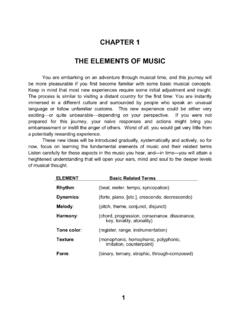Transcription of Petrarchan Sonnet - pattern & structure, with example
1 Petrarchan Sonnet EMMA LAZARUS The New Colossus Octave Not like the brazen giant of Greek fame, A With conquering limbs astride from land to land; B Here at our sea-washed, sunset gates shall stand B A mighty woman with a torch, whose flame A Is the imprisoned lightning, and her name. A Mother of Exiles. From her beacon-hand. B Glows world-wide welcome; her mild eyes command. B The air-bridged harbor that twin cities frame. A Sestet "Keep, ancient lands, your storied pomp!" cries she C With silent lips. "Give me your tired, your poor, D Your huddled masses yearning to breathe free, C The wretched refuse of your teeming shore.
2 D Send these, the homeless, tempest-tost to me, C I lift my lamp beside the golden door!" D Lazarus composed The New Colossus in the form of a Petrarchan Sonnet . There is no space between octave and sestet in her poem: the space you see between the 8th and 9th lines is inserted here to emphasize the structure. Lazarus varies the rhythm in her iambic pentameter lines, not deploying five iambic feet in each pentameter line: to hear exact iambic pentameter (5 iambs), read lines 12 and 14 aloud. Petrarchan Sonnet (ALSO KNOWN AS THE ITALIAN Sonnet ) The Petrarchan Sonnet , a form popularized but not invented by Francesco Petrarca (Petrarch, in English), consists of an octave (8 lines) with the rhyme scheme abbaabba and of a sestet (6 lines) with one of several rhyme schemes, most commonly cdecde or cdcdcd.
3 The division into an octave and a sestet characterizes the Petrarchan Sonnet s structure; the volta (a turn: a change of tone, attitude, perspective) occurs after line eight. One way of thinking about this division into octave & sestet is to approach the octave as the presentation and exploration of a problem and the sestet as the space in which the writer reaches a new understanding of that problem (though not necessarily a resolution) or discovers an insight or a revelation. The sestet is the place following the turning point volta where the unexpected arises, surprising the writer and the reader/listener.
4 Iambic pentameter (5 iambic feet: a measure of 5 iambs, an unstressed syllable followed by a stressed syllable, as in alone) is the traditional meter of sonnets written in English whether Petrarchan (Italian) or Shakespearean (English) in form. Iambic pentameter gives a writer a lot of room to expand ideas and images while maintaining a line s tension and elasticity, and also allows rhythmic variation ( counterpoint ). Iambic pentameter lines don t have to contain ten syllables, but often do. In the process of reading poems composed in iambic pentameter, you begin to internalize the meter until producing this metrical pattern becomes second nature (this takes time & practice).
5 Approaching the craft of composing a Sonnet often encourages an elevated or formal tone, which may result in a poem that sounds stilted or too regimented. That s what happens in the beginning, when one learns any new art, craft, or sport. But when you compose a Petrarchan Sonnet , aim to sound conversational despite the rigor of attempting to write fourteen lines in iambic pentameter that follow the Petrarchan rhyme scheme.






